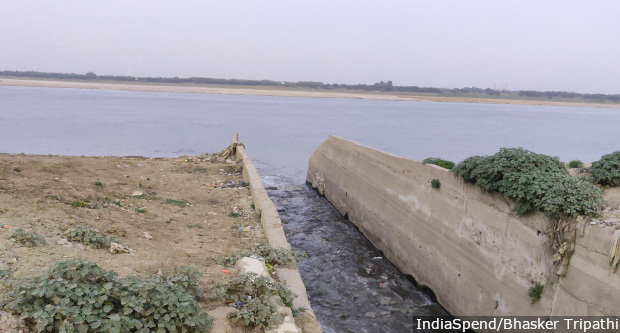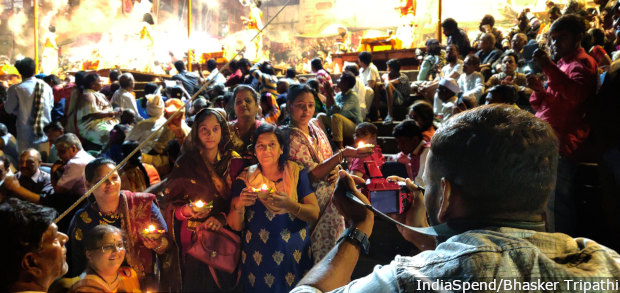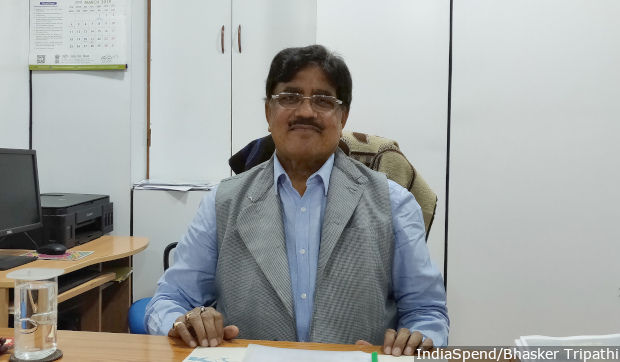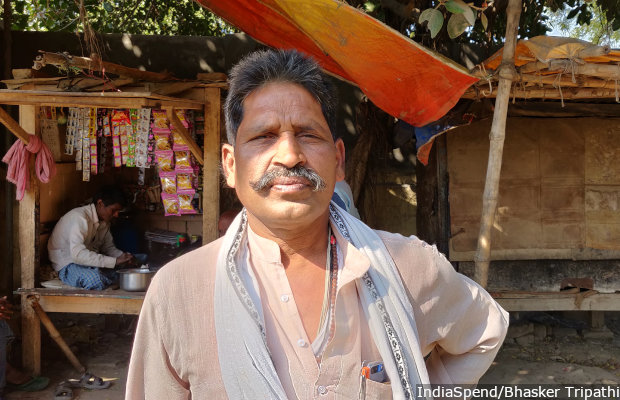Why The Grand Government Effort To Clean Up The Ganga Is Failing

All along its 10-km route through Varanasi, the Ganga, one of the world’s 10 most polluted rivers, reeks of sewage. PM Modi’s pet project to clean Ganga and its basin, one of the world’s most polluted and populous, was to be completed by 2019. The holy river today is more polluted than ever.
Varanasi: Priyanka Gandhi, general secretary of the Congress, recently rode a boat on the Ganga from Prayagraj to Varanasi in Uttar Pradesh to campaign for her party. Her journey ended at Assi Ghat in Varanasi, where the saint-poet Tulsidas is believed to have written Ramcharitmanas, an epic poem on Lord Rama.
In her speech, interrupted by cries of “Jai Hind (hail India)”, she criticised the rule of the incumbent Bharatiya Janata Party (BJP). About 100 steps from where she stood, the Assi drain discharges about 100 million litres (MLD) of sewage into the river every day, around 10,000 tanker-loads of filth (average tanker capacity at 10,000 litres). There are 80 such big drains in the city that empty into the river.
Across its 10-km route in Varanasi, the Ganga, one of the world’s 10 most polluted rivers, reeks of sewage. Every time a devotee took a dip in the river, held holy by Hindus, its surface turned black with the filth stirred up.
Pollution levels in the holy river at Varanasi are rated “severe”, the worst category, according to a 2018 report--the latest data available--of the Central Pollution Control Board (CPCB). Varanasi is the parliamentary constituency of prime minister Narendra Modi and critical to Namami Gange, the Rs 20,000-crore ($2.8 billion) flagship programme he launched in 2015 to clean the river.
A river that meanders 2,500 km from the Himalayas across the great northern plains and empties into the Bay of Bengal, the Ganga is one of the world’s most polluted and populous river basin. It is inhabited by 500 million people, more than the US and Russia combined.
“(The) need of the hour is to restore the glory of the Ganga. Today Maa Ganga is calling us, her children, to make the river clean once again," PM Modi tweeted in May 2014, soon after his party came to power and right before the BJP’s maiden budget in which the Namami Gange mission was first introduced.
By 2019, most of the drains flowing into the Ganga would stop discharging filth, the programme stated. This deadline was extended by a year to 2020, but the government promised to clean 80% of the river by 2019.
By February 2019, two months before the start of India’s 17th general elections, nearly Rs 6,000 crore ($860 million), or 30% of the Rs 20,000 crore budget, has been spent on the mission to clean the Ganga. But the river remains as polluted as ever, we found in our investigations across Varanasi district.
About 67% of the total expenses incurred so far has gone into improving sewage networks and treatment capacities in riverine cities but only a little above 10% of the required capacity has been created. A new model wherein a single private operator collects and treats the entire waste-load of these cities has significant loopholes, we found.
The Ganga’s flow is also dwindling because Uttarakhand, where the river originates, is hacking its forests to make way for construction and is dumping resulting debris in the water, as we explain later. Dams and hydel-projects, advocated by the BJP government, in the upper stretches of the river are obstructing the flow.
“The Ganga today is more polluted than before,” environmentalist Rajendra Singh, also known as ‘Waterman of India’, told The Indian Express on April 9, 2019. “Projects like Namami Gange have been limited to merely beautifying the surroundings rather than actually cleansing or removing pollutants from the river.”
This is the ninth story in our pre-election FactChecker series evaluating the government’s flagship programmes in the run-up to the 2019 general election.
The first of this series investigated the government’s rural-jobs programme (here, here and here); the second discussed the Swachh Bharat (Clean India) Mission’s sewage problem; the third (here, here and here) evaluated the Pradhan Mantri Sahaj Bijli Har Ghar Yojana (Prime Minister’s electricity-to-all-homes programme); the fourth, the fudging of open-defecation-free (ODF) status data and shoddy toilet construction–amid evident enthusiasm and success in increasing toilet access–in Uttar Pradesh, declared ODF on December 31, 2018; the fifth, similar fudging of data and widespread open defecation in Gujarat, declared ODF on October 2, 2017; the sixth explained how the skills-development mission was set to miss deadlines; the seventh probed the failures of the Prime Minister’s crop-insurance programme; and the eighth the failure of BharatNet, the project to connect India’s villages to the Internet.

Assi, one of the 80 big drains in Varanasi, discharges about 100 million litres--about 10,000 tanker loads--of raw sewage every day into the river, a few steps away from the Assi Ghat, a famous tourist spot. By 2019, the Namami Gange mission was to put an end to the flow of sewage into the Ganga. By February 2019, two months before elections, 30% of the clean-Ganga budget, Rs 20,000 crore was spent, but pollution in the river is up in Uttarakhand, unchanged in UP, Bihar and West Bengal.
Ganga more polluted than before
The Ganga has become more polluted since 2014 across stretches in Uttarakhand and remains as polluted as it was in 2014 in Uttar Pradesh, Bihar and West Bengal, said the 2018 CPCB study.
After testing the biological properties of the river water pre- and post-monsoon at 36 locations across Uttarakhand, UP, Bihar and West Bengal, results at 23 sites were compared with data for three preceding years. The results were characterised as ‘clean’, and ‘slight’, ‘moderate’, ‘heavy’ and ‘severe’ for polluted stretches.
In Uttarakhand, the water was tested at four locations. At one such location in Haridwar, the water quality improved from ‘slight’ to ‘clean’ but deteriorated at others from ‘clean’ to ‘heavy’. “In the Uttarakhand stretch, average biological water quality reflects deterioration from slight to moderate pollution [at the state level],” said the CPCB report.
Haridwar Barrage, one of 37 test locations along the river, is the only one where water quality meets the drinking-water standards, said the CPCB report. Another CPCB report from 2017 pointed out that pollution levels at 80 monitored sites on the river have risen since 2013, IndiaSpend reported on December 19, 2018.
Harmful bacteria up 84 times, 2016-2019
Biochemical oxygen demand (BOD) is the amount of dissolved oxygen needed by biological organisms to break down non-essential organic material in water, and it is harmful at high levels to both the river and creatures that dwell in it. It was more than 3 milligram/litre (mg/l) at 36 of 80 sites and 2-3 mg/l at another 30 sites in 2017. In 2013, it was more than 3 mg/l at 31 sites and 2-3 mg/l at 24, we reported.
Water with BOD levels of 2-3 mg/l is not fit for consumption and can cause serious diseases if consumed without treatment. If the BOD crosses 3 mg/l, the water is not even fit for bathing.
The Ganga at Varanasi has reached toxic levels of BOD. A study conducted by the Sankat Mochan Foundation (SMF), a nonprofit, concluded that BOD and faecal coliform bacteria in the river water along Varanasi have significantly increased over three years to 2019, Times Of India reported on March 15, 2019. Human and animal faeces are common sources of coliform bacteria.
Coliform bacteria should be in the range of 50 Most Probable Number per 100 millilitre (MPN/100ML) in drinking water and 500 MPN/100ML in bathing water.
In an upstream location in Varanasi, the faecal coliform bacteria count rose 84 times, from January 2016 levels of 450,000 to 38 million in February 2019. In a downstream location, it increased two times, from 52 million in 2016 to 144 million in 2019, as per the SMF data.
Similarly, BOD level in the stretch of river running through Varanasi rose 44%, from highest 54 milligrams per liter (mg/l) to 78 mg/l over three years to February 2019, as per the SMF data. This is 25 times the drinking water standard of BOD.

Devotees gather at Dashashwamedh ghat in Varanasi for evening ‘Ganga aarti’ (prayers). More than a million tourists visit Varanasi every month to take a dip in the river held holy by Hindus. But, the water is not fit for bathing at 36 of 80 sites monitored by the Central Pollution Control Board, up from 31 sites in 2013.
Council headed by PM never met
Cleaning up the Ganga, which flows through and carries the sewage of 53 cities, with a population of 50,000-100,000 each, and 48 towns, has been on the agenda of successive governments since 1986, when the first phase of Ganga Action Plan (GAP) was initiated. In 1993, this plan was later extended to its second phase. In 2009, the National Ganga River Basin Authority (NGRBA) was established with a goal of putting a complete stop to the discharge of sewage into the Ganga.
Namami Gange, implemented by the National Mission for Clean Ganga (NMCG) and its state counterparts, the State Programme Management Groups, promised to fulfil two big goals--turn the river nirmal (clean) and aviral (uninterrupted flow).
The National Ganga Council (NGC) was created in 2016 to oversee the cleaning of the river and replaced the NGRBA. It is headed by the prime minister and the chief ministers of the five Ganga basin states--Uttarakhand, UP, Bihar, Jharkhand, and West Bengal--and several union ministers are its members.
The NGC was supposed to meet once every year but has not met even once since it was founded, The Wire reported on March 11, 2019.
A new model for waste management
Namami Gange’s primary objective was to put an end to the direct dumping of waste in the river by creating effluent treatment plants and sewage infrastructure in all major riverine cities. Riverfronts were to be built, the ghats cleaned, afforestation initiated and toilets built in more than 4,700 villages situated on the banks of the river.
Figures from 2016, the latest available, showed that cities and towns along the Ganga generated about 2,950 MLD--about 300,000 tanker loads--of sewage every day, but existing treatment capacity could take care of 48% of this load. That leaves 1,520 MLD (52%) untreated.
Bridging this gap was one of the top priorities of the Namami Gange programme.
As on February 28, 2018, about Rs 4,250 crore ($610 million), or about 67% of Rs 6,360 crore spent thus far, had been spent on creating no more than 13% of the sewage-treatment infrastructure required in cities along the Ganga, according to an IndiaSpend analysis of the mission’s monthly progress reports.
Under the Namami Gange targets, the government was supposed to create sewage treatment capacity for 3,700 MLD but 30% of this (1,100 MLD) was to come from the rehabilitation of old treatment plants. As on February 28, 2019, the government could only create 480 MLD, 13% of the total target, with rehabilitated treatment capacity contributing 90 MLD or 8% of the target.
Of the 96 sewage-infrastructure projects sanctioned since 2015, 23, or about 24%, were completed by February 2019, 44 (46%) were under construction and no work had started on 29 (30%).
The trouble with privatising sewage treatment
To tackle sewage, the government privatised sewage treatment and collection in nearly 100 riverine cities and towns. A private operator, chosen through a bid, would handle the waste management for an entire city.
These operators were to build and operate sewage treatment plants for 15 years, after which they would be handed over to the state. To ensure quality service, a significant part of the bid amount was to be paid in yearly installments linked to the quality of the treated water. The water quality was to be mainly monitored through online sensors.
“The main problem with this model is that the involvement of experienced government engineers like me is almost non-existent,” said Gyanendra Pratap Singh, an engineer of the Varanasi Jal Nigam, a government corporation. “The monitoring is mostly dependent on sensor monitoring, which can be calibrated to produce a certain result.”

Gyanendra Pratap Singh, an engineer with the Varanasi Jal Nigam, a government corporation, believes that the new government strategy to get a private contractor to collect and treat waste in nearly 100 cities and towns located in the Ganga basin is flawed. “The monitoring [in the new process] is mostly dependent on sensor monitoring, which can be calibrated to produce a certain result,” he told IndiaSpend.
Projects like these are not bringing any technology or skill improvement to bodies like the Jal Nigam, which will take over plant handling after 15 years of private management, said Singh.
Measuring sewage
The management of sewage in riverine cities like Varanasi is complex for other reasons: the assessment of sewage generated is, often, flawed and there aren’t enough sewers to convey the sewage to treatment plants, said BD Tripathi, chairman, Mahamana Malviya Ganga Research Centre of Banaras Hindu University (BHU).
The sewage generated in a city is measured by the amount of water supplied. But this does not take into account water drawn from private tubewells and submersible pumps, which is more than the supplied water in most cities, said Tripathi.
Varanasi generates about 350 MLD of sewage, according to city authorities, and about 250 MLD can currently be treated. Upcoming projects will boost this capacity by 50 MLD. But, according to independent research, the city generates about 500-600 MLD sewage every day, nearly twice the official estimate, but this has not been officially confirmed, said Tripathi.
Also, most working sewage-treatment plants along the Ganga cannot treat the heavy metals that mix with household sewage, as happens in Varanasi, which is dotted with small industrial clusters, Tripathi said.
Most riverine UP cities, such as Varanasi, Allahabad and Kanpur, do not have enough sewers to carry sewage to treatment plants. This means some treatment plants are operating under capacity, Tripathi added.

BD Tripathi, chairman, Mahamana Malviya Ganga Research Centre of Banaras Hindu University, who has spent 40 years researching the river, thinks that the issue is not so much about ridding the Ganga of sewage but maintaining its flow so it can “self-purify”.
For example, Varanasi’s biggest sewage-treatment plant at Dinapur can treat 140 MLD sewage, but, on average, treats 80 MLD, 43% less than capacity.
Under the Namami Gange mission, in most cities, the government does not intend to build sewer system. Instead, it will pick up the sewage from drains using weirs and pumps before discharging it into the river and then channel it to the treatment plants. The other plan is to use treated water for industrial or agriculture purposes.
Farmers wary of treated sewage
Most farmers, we found, believed that treated sewage harms crops. Awadhesh Kumar Singh (45), a farmer in Dinapur village 10 km north-east of Varanasi city, owns a farm near a canal flowing with treated water. This water destroys crops, complained Singh, who cultivates rice, wheat and rose (Varanasi is big floriculture hub).
Before being rehabilitated into an advanced plant of 140 MLD in December 2018, the older Dinapur treatment plant worked at 80 MLD capacity. Singh and other farmers of the village used the free canal water from the old plant till about six years ago.

Awadhesh Kumar Singh (45), a farmer in Dinapur village 10 km north-east of Varanasi city, owns a farm fed by a canal with treated sewage water. While the government plans to supply this water for irrigation, instead of releasing it in the Ganga, Singh and fellow farmers say that the water from these plants destroys the crops. “We stopped using the treated water and switched back to tube-wells,” says Singh.
“After irrigating our crops with the treated water for two years, we realised that weird things started happening to our produce,” said Singh. “Wheat or rice crop will look really healthy from outside but the buds started shrinking in size.”
Dinapur village was famous for its brinjals till, the farmers said, they started using treated water. “We were alarmed when we realised that 2-3 cm of the upper layer of our farm soil turned dry,” said Singh. “We stopped using the treated water and switched back to tube-wells: over the next two years our soil started recovering.”
‘Dwindling flow is the real problem’
The issue is not so much about ridding the Ganga of sewage but of maintaining its flow so it can “self-purify”, said Tripathi who researched the river for 40 years. “If the flow in the river is maintained it can solve the problem of 60-80% of organic pollutants and we may not require so much money going into maintaining the quality of the water,” he said.
That is difficult because the Himalayan region faces deforestation and construction, the resulting debris silting the river. The river is turning shallow, being encroached on and its capacity to carry water is falling, Tripathi explained.
Dams, irrigation canals and ground water extraction are other factors affecting the flow of the Ganga, he said. There are about 149 dams, 107 barrages and weirs and over 75,000 km of canals on the entire stretch of the Ganga, according to the National Mission for Clean Ganga.
The river’s baseflow--sustained low flow in a river during dry or fair weather conditions--has decreased by 56% over 46 years to 2016, said an August 2018 paper published by the Indian Institute of Technology, Kharagpur. So, more groundwater is pumped out, it said.
Dams affecting flow
In the upper regions of Uttarakhand, dams divert the waters of the Bhagirathi and Alaknanda rivers--both converge at Rudraprayag to become the Ganga--to produce electricity, reducing the flow of the river but also its biodiversity by shifting its natural route, said Tripathi.
Uttarakhand, over 10 years to 2019, has signed agreements to build more than 300 dams. The state already has more than 90 hydel-electricity projects.
About 70% of the Bhagirathi and nearly 50% of the Alaknanda have been inundated and diverted due to 16 existing, 14 ongoing and 14 proposed hydroelectric projects turning a third of the river channels into “ecological deserts”, said a 2018 study by the Dehradun-based Wildlife Institute of India, a government-funded research institute.
After coming to power in 2014, the BJP-led government rolled back many environmental regulations that stopped new hydel projects on the river, Scroll.in reported on January 17, 2018.
After the Kedarnath cloudburst, which killed about 5,000 people and destroyed more than 4,000 villages, the Supreme Court banned construction of new hydel projects in Uttarakhand. But the BJP-led central government reduced the ban to 24 “sensitive” hydel projects, said the Scroll.in report.
‘Defecation-free’ Ganga villages
Human faeces dotted the narrow road that led to the panchayat (village council) office of Domari village, located about 10 km east of Varanasi city. This village is classified as a “Ganga Gram”, a village located along the river. It has been declared open defecation free (ODF), along with other 50 villages located along the river in Varanasi district.
Nearly 100% of all the 4,700 villages located on the banks of Ganga in riverine states have been declared ODF by the government under the Swachh Bharat Mission.
The entire village uses toilets, declared the gram pradhan (village head) of Domari, Chhotelal. Geeta Singh (40), an anganwadi worker, said many village elders still do not use toilets.
The objective of making Ganga Grams ODF was to reduce faecal coliform bacteria in the river, but the data suggest that has not happened.
Faecal-coliform counts in riverine cities ranged from 2,500 to 240,000 per 100 ml in May 2018, according to data provided by pollution control boards of the five Ganga basin states. The standard is 2,500 per 100 ml.
This story is part of “Modi’s Report Card”, a series evaluating flagship government programmes in the run up to the 2019 general elections. You can read a set of stories on the rural jobs programme here, here and here; on the rural electrification programme here, here and here; on Swachh Bharat Mission here, here and here; the skills-development mission here; the crop-insurance scheme here and the digital empowerment of villages here.
(Tripathi is a principal correspondent with IndiaSpend and FactChecker.in.)
We welcome feedback. Please write to respond@indiaspend.org. We reserve the right to edit responses for language and grammar.


